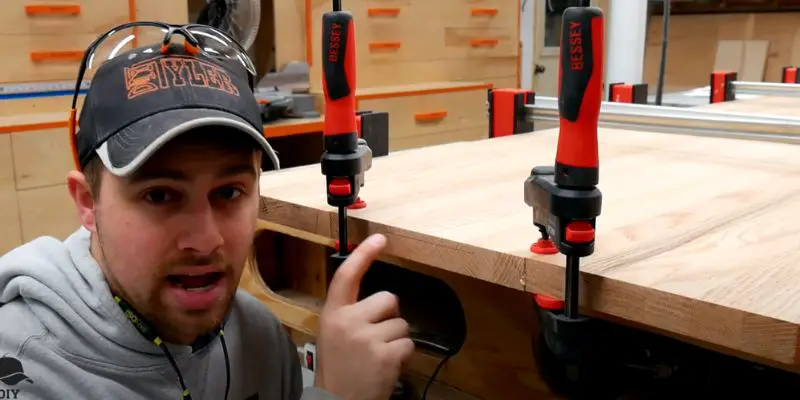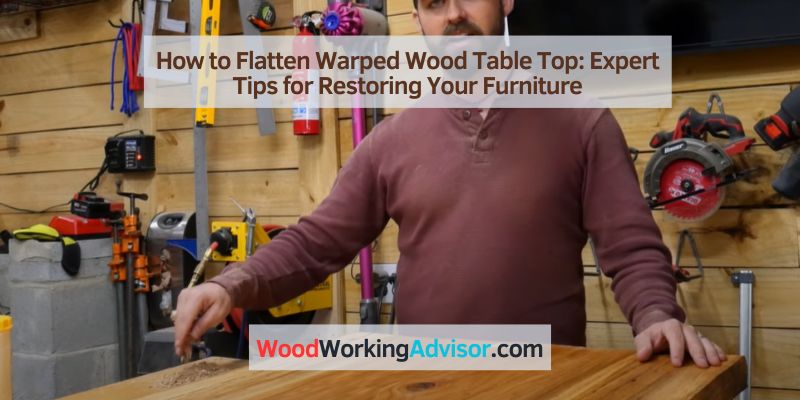To flatten a warped wood table top, you can use moisture and weights. Simply dampen the concave side and place weights on top.
Let it dry flat for a few days. Dealing with a warped wood table top can be frustrating, but there are effective methods to resolve this issue. Whether it’s due to changes in humidity or an uneven drying process, a warped table top can detract from the beauty and functionality of the furniture piece.
However, by taking the appropriate steps, you can restore the table top to its original flat state. We will explore a simple and practical method to flatten a warped wood table top, using moisture and weights. By following these steps, you can bring your table top back to its former glory, ensuring it remains a stunning and functional centerpiece in your space.
Assessing The Damage
When it comes to assessing the damage of a warped wood table top, understanding the causes and knowing how to identify and measure warping are essential. Let’s delve into these aspects to learn how to effectively evaluate and address a warped table top.
Understanding The Causes Of Table Warping
Wood warping can be attributed to several factors, with environmental conditions playing a significant role.
Factors contributing to wood warping
- Moisture content variation
- Uneven drying
- Wood grain orientation
Impact of environmental conditions
The exposure to fluctuating temperature and humidity levels can lead to table warping.
Identifying And Measuring Warping
Tools and techniques for assessing warping
To accurately assess wood table warping, a combination of visual inspection and specialized tools can be utilized, including:
- Straight edge or flat surface
- Feeler gauges
- Calipers
Importance of accurate measurements
Precise measurements are crucial for devising an effective flattening strategy.

Selecting The Right Repair Method
When it comes to fixing a warped wood table top, selecting the right repair method is crucial to ensuring a successful outcome. There are various techniques to choose from, each with its own set of pros and cons. Understanding these methods and considerations can help you make an informed decision on how best to approach the flattening process.
Evaluating Different Flattening Techniques
Before diving into the repair process, it’s essential to evaluate the different flattening techniques available. Understanding the key differences between heat-based and moisture-based methods can help determine which approach aligns with the specific needs of the warped table top.
Comparing Heat-based And Moisture-based Methods
Heat-based methods, such as using a heat gun or an iron, involve applying controlled heat to the warped areas to encourage the wood fibers to expand and relax, allowing the table top to flatten. On the other hand, moisture-based methods, such as the use of damp towels or steam, focus on introducing moisture to the wood to promote swelling and subsequent flattening.
Pros And Cons Of Each Approach
Both heat-based and moisture-based methods have their advantages and limitations. While heat-based techniques can offer quick results and are suitable for certain wood types, they may pose a risk of scorching the wood if not executed carefully. Moisture-based methods, while effective in addressing severe warping, require longer periods of time and careful monitoring to avoid overexposure to moisture.
Considerations For Wood Type And Finish
When considering the repair method, it’s important to take into account the type of wood used for the table top and its existing finish. Different wood species may respond differently to heat and moisture-based techniques, necessitating a tailored approach to achieve optimal results. Additionally, compatibility with the table’s finish is essential to prevent damage to the surface during the repair process.
Effect Of Wood Species On Repair Method Selection
Wood species, such as oak, maple, or cherry, exhibit varied responses to heat and moisture-based methods due to their unique grain and density characteristics. Understanding how each wood type reacts to different techniques can aid in selecting the most suitable approach for flattening the warped table top.
Compatibility With Different Table Finishes
The compatibility of the repair method with the table’s finish is crucial to avoiding any adverse effects on the surface appearance and integrity. Choosing a technique that aligns with the specific finish, whether it’s varnish, lacquer, or oil-based, is vital to ensure a successful and seamless repair process.
Implementing The Repair Process
Flattening a warped wood table top is essential to restore its functionality and aesthetics. Once you have identified the type and extent of warping, it’s time to implement the repair process. This involves carefully preparing the work area and table surface, cleaning and clearing the workspace, taking precautions for different finishes, and applying the chosen correction method.
Preparing The Work Area And Table Surface
Before starting the repair process, it’s important to prepare the work area and table surface properly.
Cleaning And Clearing The Workspace
Ensure the workspace is free of any clutter or debris that could interfere with the repair process. Clean the table surface to remove any dust or particles that could affect the bonding of materials.
Precautions For Working With Different Finishes
When dealing with different finishes on the table, such as varnish or paint, it’s crucial to take appropriate precautions to prevent damage. Use suitable products and techniques that won’t compromise the original finish.
Applying The Chosen Correction Method
Once the work area and table surface are prepared, it’s time to apply the chosen correction method to flatten the warped wood table top.
Step-by-step Guide To Implementing The Selected Technique
Based on the type and extent of warping, follow a step-by-step guide for the chosen technique. Whether it involves using moisture, heat, or pressure, ensure each step is carried out accurately and patiently to achieve the desired result.
Factors Influencing Repair Success
Several factors, such as the type of wood, the severity of warping, and the applied technique, play a crucial role in the success of the repair process. Keep these factors in mind to ensure a successful outcome.
Protecting And Maintaining The Flattened Surface
To protect and maintain the flattened surface of a warped wood table top, it is essential to use a protective finish such as varnish or polyurethane. Regular maintenance and inspection can help prevent warping and ensure the surface remains flat and smooth.
Additionally, utilizing table pads or coasters can minimize damage from heat and moisture.
Securing Long-term Results
Sealing And Protecting The Repaired Surface
Sealing the repaired surface is crucial for safeguarding it against future warping and damage. Apply a high-quality wood sealant or finish to protect the wood from moisture and environmental elements. Regularly inspect the surface for any signs of wear and tear, and reapply the sealant as needed to maintain its protective properties.
Preventing Future Warping And Damage
To prevent future warping and damage, it’s essential to keep the table top away from direct sunlight, extreme humidity, and rapid temperature changes. Use coasters, placemats, or tablecloths to protect the surface from spills, heat, and scratches. Additionally, invest in a dehumidifier to control the humidity levels in the room where the table is located.
Routine Care And Maintenance
Implementing a regular routine for caring and maintaining the flattened table top is paramount. This involves dusting the surface frequently with a soft cloth and using a gentle wood cleaner to remove any stubborn dirt or marks. A periodic application of wood polish can help keep the surface looking vibrant and healthy.

Best Practices For Preserving A Flattened Table Top
Adhering to best practices is key to preserving a flattened table top. Avoid placing heavy or unevenly distributed items on the surface, as this can strain the wood and lead to warping. By following these practices, you can prolong the life and aesthetics of the repaired wood table top.
Cleaning And Caring For The Restored Wood Finish
When it comes to cleaning and caring for the restored wood finish, utilize a mild wood cleaner and a soft cloth to gently wipe the surface. This will help maintain the integrity of the wood and prevent any potential damage. Regularly inspect the finish for any areas that may require additional attention.
Frequently Asked Questions On How To Flatten Warped Wood Table Top
Can You Unwarp Wood Table Top?
Yes, you can unwarp a wood table top by applying moisture to the concave side and heat to the convex side. Then, place heavy weights on the table to flatten it. Sand and refinish the surface to smooth out any remaining imperfections.
How Do You Get Warped Wood To Lay Flat?
To flatten warped wood, place it on a flat surface and apply even pressure using weights or clamps. Leave it for a few days until it regains its shape. Another method is to use moisture, like spraying or soaking the wood and then applying pressure.
How Do You Flatten A Wood Table Top?
To flatten a wood table top, sand it evenly with a belt sander or hand sander. Use 80 to 100 grit sandpaper for heavy spots and 120 to 150 grit for lighter areas. Finish with 180 to 220 grit sandpaper to smooth the surface and remove any marks.
How Do You Level A Warped Table Top?
To level a warped table top, use a plane and sandpaper for subtle imperfections. For larger warps, use moisture and clamps to gradually straighten the wood. Always measure and check for evenness throughout the process. Regularly assess the table’s stability after each adjustment.
Conclusion
Incorporating the methods mentioned can help you restore your warped wood table top effectively. By following these simple steps, you can effortlessly bring back the original flatness of your table surface. With patience and the right techniques, you can enjoy a beautifully restored table for years to come.



9 thoughts on “How to Flatten Warped Wood Table Top: Expert Tips for Restoring Your Furniture”